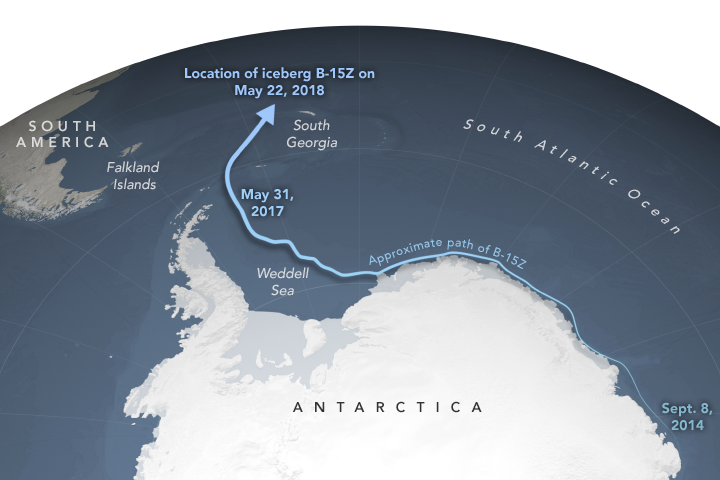World’s Largest Iceberg Is Melting Away After 18 Years Adrift
In the last two years, the Jamaica-sized berg began venturing north, melting and splintering into pieces along the way
/https://tf-cmsv2-smithsonianmag-media.s3.amazonaws.com/filer/e1/90/e19015eb-64d9-4914-9268-3c7034e41e00/b15.jpg)
In late March, 2000, an iceberg larger than Jamaica, the largest ever recorded, broke off Antarctica’s Ross Ice Shelf. Over the last 18 years, researchers have tracked iceberg B-15 as it drifted around the continent and eventually northward. Now, reports Brandon Specktor at LiveScience, B-15 has drifted close to South Georgia Island and a new image suggest its wild ride is almost over.
When it first broke away from Antarctica, B-15 stretched 170 miles long and 25 miles wide, with a surface area of 4,250 square miles. By 2015, the original iceberg had broken into eight major fragments. But now, only four remaining pieces meet the minimum size requirement (20 square nautical miles) to be tracked by the National Ice Center.
Last month, astronauts on the International Space Station captured an image of B-15Z, one of the largest remaining fragments. Though the ice chunk is currently 11.5 miles long and just under six miles wide, it's showing signs of breaking down. According to a press release, a large fracture runs down its center, and smaller pieces are breaking from the edges. If the berg gets too small, the NIC can no longer track it. The other fragments will likely soon meet the same fate as they continue northward toward the equator.
If B-15 had stayed in the South Atlantic, rapid melting wasn't inevitable; icebergs can hold on for decades within Antarctica’s coastal currents. But as Specktor reports, after traveling roughly three-quarters of the way around the continent, the iceberg encountered additional currents near the tip of the Antarctic Peninsula. These prevented it from drifting through the Drake Passage—a channel that runs between the southern tip of South America and Antarctica. Instead, it started on a northward trajectory toward warmer climes.
Bergs that make it as far north as South Georgia are known to melt off quite rapidly, even if they are the world’s largest reports NASA. “Spoiler alert: they tend to pond with water, which then works its way through the iceberg like a set of knives,” says NASA glaciologist Kelly Brunt. “This is often the end of the life cycle of a lot of Antarctic icebergs.”

B-15 isn’t the only gigantic Antarctic iceberg that researchers are keeping track of. Last July, a massive berg (but not as massive at B-15) called A-68 broke away from the Larsen C ice shelf. Earlier this year, researchers tried to reach the iceberg’s origin point to study newly uncovered zones of the seafloor that have not been seen for thousands of years, but they were not successful.
Every time a massive iceberg breaks off, public speculation rises about the effects of climate change. But as glaciologist Adrian Luckman, who has extensively studied A-68, explains for The Conversation, it’s a complicated story. He writes about A-68: “[D]espite the media and public fascination, the Larsen C rift and iceberg ‘calving’ is not a warning of imminent sea level rise, and any link to climate change is far from straightforward.” Similarly, B-15 seems to be part of a “normal process in which the ice sheet maintains a balance between constant growth and periodic losses,” according to NSF.
But that’s not the case for every break. Scientists believe that climate change may be helping to drive an unstoppable collapse of the Western Antarctic ice sheet.
Whatever the source, although B-15 is no more, there will definitely be more icebergs to come.